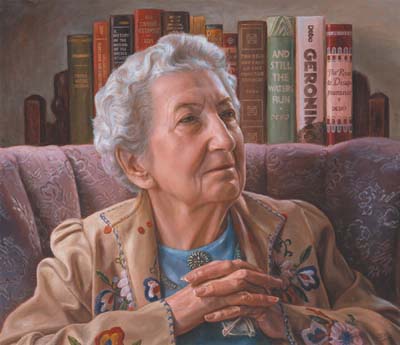 (left: Charles Banks Wilson (b. 1918) American,
DR. ANGIE DEBO, oil on canvas, 1985, Courtesy of the Capitol Preservation
Commission and the Oklahoma Arts Council)
(left: Charles Banks Wilson (b. 1918) American,
DR. ANGIE DEBO, oil on canvas, 1985, Courtesy of the Capitol Preservation
Commission and the Oklahoma Arts Council)Gilcrease Museum
Tulsa, OK
918/596-2700, toll-free at 888/655-2278
Capitol Portraits
July 4 - December 31, 2001
During the construction of the dome on the state capitol in Oklahoma City, the large portraits of prominent Oklahomans that were commissioned for the capitol building are on loan to Gilcrease. This is first time that these works, painted by Charles Banks Wilson, have been away from the Oklahoma State Capitol. Included are portraits of Carl Albert, Angie Debo, Robert S. Kerr, Wiley Post, Will Rogers, Sequoyah, and Jim Thorpe. In conjunction with this special exhibition, Gilcrease Museum will display additional paintings by C. B. Wilson that are in the museum's permanent collection. Also featured is artist Mike Wimmer.
Selected wall text follows, including biographies of artists in the exhibition. Text and images courtesy of the Gilcrease Museum:
Charles Banks Wilson
Charles Banks Wilson is an important regional artist who has spent much of his career painting documentary portraits of Oklahomans. His great skill as a portraitist and his rapport with his subjects have helped create a body of work that is historically notable as well as aesthetically significant.
Born in Springdale, Arkansas, in 1918, and raised in Miami, Oklahoma, Wilson was accepted at the prestigious Art Institute of Chicago in 1936 to study painting, watercolor, and lithography. He completed his formal training with high awards and honors. After serving an apprenticeship with illustrators at the Chicago Tribune, who taught him the humor in art, Wilson came to the attention of the prominent artist, Thomas Hart Benton (1899-1975). Through Benton's recommendation, Wilson went to New York City to provide a print for a folio being prepared by the American Art Association. From that start Wilson began his career as a book illustrator.
Wilson returned to Oklahoma during World War II and began teaching night classes at Northeastern A&M College in Miami. He was so popular that his teaching load increased to the point that he established the art department and served as its head for fifteen years. Although Wilson was an inspiring and engaging teacher, he left the profession, feeling he could no longer contribute what he thought the task demanded. Since 1960 he has painted full time.
Wilson has gained recognition for his oil paintings, such
as the images of famous Oklahomans in the state capitol. Working in a variety
of media, from painting to sculpture, he has also made the exacting medium
of egg tempera a specialty. Charming scenes of rural midwestern life make
up another facet of Wilson's artistic personality. Reflecting knowledge
and understanding of people and places, his paintings of boys swimming on
hot summer days and farmers tending fields or a sorghum mill recall a simpler
time. Painted in what is often referred to as a Regionalist style, Wilson's
images are rhythmic and dynamic. American Indian life is a frequent subject
of Wilson's work. Years of study, including sketching several hundred individuals
described as Purebloods, attending ceremonies, as well as mutual respect
and admiration, are evident in his portraits and scenes.
 (left: Charles Banks Wilson (b. 1918) American,
DR. ANGIE DEBO, oil on canvas, 1985, Courtesy of the Capitol Preservation
Commission and the Oklahoma Arts Council)
(left: Charles Banks Wilson (b. 1918) American,
DR. ANGIE DEBO, oil on canvas, 1985, Courtesy of the Capitol Preservation
Commission and the Oklahoma Arts Council)
Angle Debo (1890-1988) is remembered as one of Oklahoma' s most prominent historians. Debo's family arrived in Oklahoma Territory in a covered wagon and settled on a farm near Marshall in 1899. Between 1915 and 1933 she earned a bachelor's degree and a doctorate from the University of Oklahoma and a master's degree from the University of Chicago. Debo taught history and was a librarian for many years. She eventually authored or edited more than a dozen volumes and wrote numerous journal articles. And Still the Waters Run: The Betrayal of the Five Civilized Tribes is her most highly esteemed work. Utilizing primary sources, Debo documented how Indian lands and benefits were stolen. In 1940 it was released by Princeton University Press. Many leading Oklahomans were disparagingly characterized and certain names were extracted to avoid libel suits. In 1977 Debo wrote, "If one were to put everything I have written on one side of the scales, and that book on the other side, it would outbalance them all."
In 1985 Oklahoma placed her portrait in the capitol rotunda,
describing her as "a treasure for the whole state." In preparing
the portrait, artist Charles Banks Wilson remarked, "I felt that her
integrity and great accomplishments deserved the best painting I could do.
She was ninety-four years old in 1984, when she posed for me in the dining
room of her small, white farm house in Marshall, Oklahoma, where everyone
calls her 'Miss Angie.'"
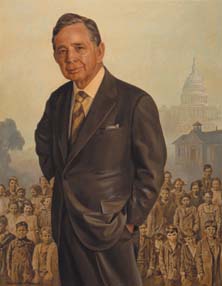 (left: Charles Banks Wilson (b. 1918) American,
CARL ALBERT, oil on canvas, 1977, Courtesy of the Capitol Preservation Commission
and the Oklahoma Arts Council)
(left: Charles Banks Wilson (b. 1918) American,
CARL ALBERT, oil on canvas, 1977, Courtesy of the Capitol Preservation Commission
and the Oklahoma Arts Council)
Carl Albert (1908-2000) was elected to the United State's Congress from Oklahoma in 1946. He was reelected fourteen times, holding the seat for thirty years. In 1954 he was named to the third-ranking post in the majority party's leadership, the Democratic Party "whip." In 1962 he began service in the second-ranking position, House majority leader. And in 1971 Albert became the Speaker of the House of Representatives. This is the highest government position yet held by an Oklahoman.
The future Speaker was born in the community of Bug Tussle, near McAlester, Oklahoma. His father was a coal miner and farmer, and the family lived in a log cabin. Young Albert became the first in his family to graduate from high school and the first from Bug Tussle to graduate from college. After completing studies at the University of Oklahoma, he won a Rhodes scholarship and received two degrees from Oxford University. He then worked for the Federal Housing Administration, practiced law (specializing in proceedings relating to the oil industry), and served in the army during World War II.
During his three decades in Congress, Albert promoted the interests of Oklahoma. He supported public works projects and agricultural measures. As the 46th Speaker of the House of Representatives, from 1971-1976, he worked through the turbulence of the Vietnamese War, bussing issues relating to school desegregation, an energy crisis, and the turmoil in the executive branch of government with the resignation of Vice President Agnew, the Watergate hearings, and finally the resignation of President Nixon. In representing the Third District, a region in southeastern Oklahoma known for its ties to Southern traditions, Carl Albert became known as "the little giant from Little Dixie."
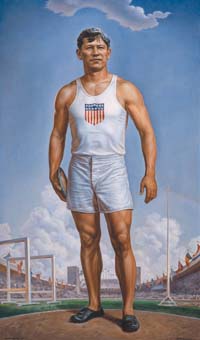 (left: Charles Banks Wilson (b. 1918) American,
JIM THORPE, 1888-1953, oil on canvas, 1968, Courtesy of the Capitol Preservation
Commission and the Oklahoma Arts Council)
(left: Charles Banks Wilson (b. 1918) American,
JIM THORPE, 1888-1953, oil on canvas, 1968, Courtesy of the Capitol Preservation
Commission and the Oklahoma Arts Council)
Jim Thorpe (1888-1953) won the decathlon and pentathlon at the 1912 Olympic Games in Sweden, and King Gustav pronounced him "the greatest athlete in the world." In 1950 Thorpe was voted the best athlete of the first half of the century in an Associated Press poll. He is still considered one of the most talented athletes of all time.
Thorpe was born in Prague, Oklahoma Territory. He was a member of the Sauk and Fox tribe and a descendent of the leader, Black Hawk. In 1904 he was sent to the government school for Indians at Carlisle, Pennsylvania. While there he became a prominent football player. Thorpe left school in 1908 to play baseball in the Eastern Carolina League, earning fifteen dollars a week. In 1911 he returned to Carlisle and to football. In an eighteen to fifteen win against Harvard, Thorpe scored all of the school's points with a touchdown and four field goals. The following year, 1912, he established a long-standing record of twenty-five touchdowns and 198 points. During this time he also competed in the Olympics. Following the disclosure that he had played professional baseball, Thorpe was required to return his gold medals. Not until 1983 did the International Olympic Committee restore his amateur status and present duplicate medals to his heirs.
Continuing his athletic career, Thorpe played baseball
for the New York Giants, the Cincinnati Reds, and the Boston Braves from
1913 through 1919. He then played football with a number of teams, making
his final appearance in 1929. He became the first president of the American
Professional Football Association. Jim Thorpe was also named to both the
college and professional football halls of fame.
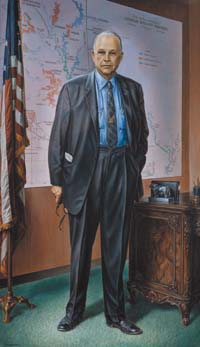 (left: Charles Banks Wilson (b. 1918) American,
ROBERT S. KERR, oil on canvas, 1966, Courtesy of the Capitol Preservation
Commission and the Oklahoma Arts Council)
(left: Charles Banks Wilson (b. 1918) American,
ROBERT S. KERR, oil on canvas, 1966, Courtesy of the Capitol Preservation
Commission and the Oklahoma Arts Council)
Robert S. Kerr (1896-1963) was a successful oilman and founder of Kerr-McGee Oil Industries. He served as the twelfth governor of Oklahoma and as United States Senator from 1948 until his death. He is perhaps best remembered for the development of the Arkansas River Navigation System. Envisioning the system as a means to flood control and creation of a navigation system, Kerr worked to attain federal approval for the plan. Supervised by the U.S. Army Corps of Engineers, the project involved work on the 448-mile channel of the Arkansas and Verdigris Rivers; five locks and darns, three lakes in Oklahoma and thirteen in Arkansas. At a total cost of $1.2 billion, the system was one of the largest civil works projects ever undertaken by the federal government.
Kerr, whose birthplace was a log cabin in the Chickasaw Nation, struggled to attain his education and eventually received a law degree from the University of Oklahoma. During World War I, he served with the American Expeditionary Force as an artillery officer in France. Kerr was later elected commander of the American Legion in Oklahoma, became a well known attorney, a leader in the Southern Baptist Convention, and a prominent oil producer. In the 1930s, Kerr focused his great personal energy on politics. He accepted appointments to a series of state positions and Democratic party offices. In 1942 he was elected governor.
As Oklahoma's first native-born governor, Kerr developed good relations within the state legislature. He also carefully supported and cultivated national political leaders. His efforts earned Oklahoma numerous military installations and impressive economic growth during the years of World War II. Next elected to the U. S. Senate, Kerr achieved prominence and influence because of his legislative work on the regulation of gas and oil production, expansion of the Social Security program, the development of medical care programs for the aged, and the manned space program. He served on several important committees and forged alliances with leaders such as John Kennedy and Lyndon Johnson. Upon his death Robert Kerr was lauded as the "uncrowned King of the Senate."
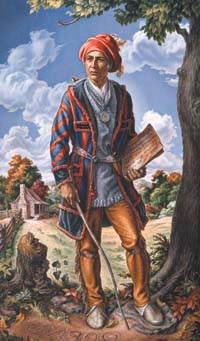 (left: Charles Banks Wilson (b. 1918) American,
SEQUOYAH, oil on canvas, 1965, Courtesy of the Capitol Preservation Commission
and the Oklahoma Arts Council)
(left: Charles Banks Wilson (b. 1918) American,
SEQUOYAH, oil on canvas, 1965, Courtesy of the Capitol Preservation Commission
and the Oklahoma Arts Council)
Sequoyah (c. 1770s-1843) was the only American Indian north of Mexico to invent a method of expressing a native language in a written form. His writing system, perfected about 1821, offered a new means of communication to the Cherokee people. However, there remains much controversy concerning the life and work of Sequoyah. His native name was Sikwayi, which became Sequoyah to non-Cherokee speakers; he was also known as George Gist or George Guess. His father, a British merchant and later an American soldier, was absent from Sequoyah's life. He grew up in the care of his mother, in eastern Tennessee, surrounded by Cherokees following traditional beliefs. Perhaps as early as 1809, he became interested in the concept of a written language and began to experiment with designing a pictograph for every word. Gradually this concept was refined, and he divided the Cherokee language into eighty-six syllables. Through his invention, which was made public in 1821, he hoped to preserve Cherokee culture and religion. Sequoyah, always opposed to assimilation, had moved to Georgia and then to Alabama. In 1822 he migrated to Arkansas.
Sequoyah's invention was so phonetically accurate that
native speakers could master the written language in only a few days. Within
months thousands could read and write in their own language. Later the syllabary
was designed into a movable type, which allowed for the printing of the
Cherokee Advocate newspaper and other documents in the Cherokee language.
The system was slightly modified - there had been no consideration for capitalization,
punctuation, standardized spelling, or dialect. The syllabary became a great
source of Cherokee national self-respect and pride. In 1824 the Cherokee
National Council acknowledged Sequoyah's remarkable invention by having
a medal struck in his honor and by awarding him $500 as a tribute to "the
great benefits of your incomparable system." In 1847 the giant redwood
trees of California were named sequoia gigantean in his honor.
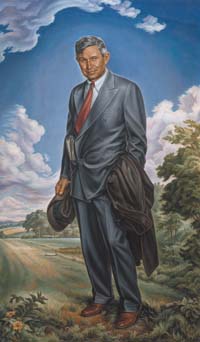 (left: Charles Banks Wilson (b. 1918) American,
WILL ROGERS, egg tempera on canvas, 1964, Courtesy of the Capitol Preservation
Commission and the Oklahoma Arts Council)
(left: Charles Banks Wilson (b. 1918) American,
WILL ROGERS, egg tempera on canvas, 1964, Courtesy of the Capitol Preservation
Commission and the Oklahoma Arts Council)
Will Rogers (1879-1935) was one of America's most celebrated humorist and one of Oklahoma's most beloved citizens. He was born near Oologah in the Cherokee Nation. During his youth on the family ranch, he became a skilled horseman and expert in trick roping as well as work roping. In 1902 he joined a Wild West show in Argentina as "The Cherokee Kid." He also performed in circuses and in vaudeville. His demonstrations of rope tricks gradually gave way to humorous monologues. By 1921 he was featured in Ziegfeld's Midnight Frolic. He also was featured in a popular radio program and in the late 1920s and early 1930s appeared in numerous successful films. Among his most popular films were A Connecticut Yankee in 1931, State Fair in 1933, and David Harum in 1934.
Gradually Rogers' career as a comedian expanded to include written humor. Between 1919 and 1929 he authored six books. Rogers' books include The Cowboy Philosopher on Prohibition (1919), The Cowboy Philosopher on the Peace Conference (1919), What We Laugh At (1920), The Illiterate Digest (1924), Letters of a Self-Made Diplomat to his President (1927), and Will Rogers' Political Follies (1929). Selections of his publications remain in print. In 1922 he began writing a daily newspaper column. Eventually, approximately 600 daily and weekly newspapers carried the column. His sayings were often quoted, such as "All I know is just what I read in the papers," and "Everything is funny as long as it is happening to somebody else."
Rogers' quick wit and wry observations made him a legend. He was considered a national institution and an international celebrity. At the time of his death in an aviation accident in 1935, perhaps no other American humorist had ever reached such a large audience or attained such universal popularity.
Mike Wimmer
Mike Wimmer was born in Muskogee, Oklahoma where he grew up like most boys playing hard, fighting sleep, reading comic books and dreaming. "Thanks to my very active imagination and the physical development handed down to me through my grandfather, I was able to chase and sometimes catch many of my dreams." Dreams that included one day winning a bodybuilding championship, being a football star, or living the adventures of his favorite literary characters, King Arthur, Robin Hood, or a salty high seas pirateer. His art development, with the help of comic books and boy's adventure stories, was well nourished and supplied by his parents who themselves had no knowledge or understanding of such talents. But, in their own words, "It kept him active, out of trouble and above all, quiet."
Without formal education or training he naively set out for studies at the University of Oklahoma where the opportunity to work with Don Ivan Punchatz at his famous Sketch Pad Studio in Arlington, Texas availed itself. While working as an apprentice for two and a: half years, Mike learned the business end of illustrating while also learning the painting techniques and working methods of many of the local Dallas illustrators. Afterwards he moved back to Norman, Oklahoma so that his wife, and childhood sweetheart, Carmelita could finish her studies in early childhood education, and where he could set up his studio to begin his life as an illustrator and artist.
Mike's career started out slow but it wasn't long before his portfolio was full and his workday busy. Most of his clients were local in the beginning but after a whirlwind tour of New York he began working more on a national scale and his work began to take on a broader audience, Mike has illustrated many children's hook covers and is the illustrator of Train Song by Diane Siebert, 1992 NCSS/CBC Notable Children's Trade Book in the field of Social studies and a Redbook Best Book for 1990. Flight: The Journey of Charles Lindbergh by Robert Burliegh, published by Putnam Philomel was the winner of the Orbis Pictus Award for Outstanding Nonfiction for Children 1990. All the Places lo Love by Patricia MacLachlan, was published in 1994 by Harper Collins and has become a favorite of every generation. It also won the Oklahoma Book award for Best Illustrated Children's book for 1995. Home run: The Story of Babe Ruth, Mike's second book with Bob Burliegh,: was published in 1997 by Harcourt Brace and has been included on many state book award lists. In 1999 Simon and Schuster published Summertime - from Porgy and Bess, George and Ira Gershwin with Dubose and Dorothy Hayward. Mike is now currently working on Will Rogers with Governor Frank Keating. It is scheduled to be out for the summer of 2002.
Mike's workday starts early. Arise; get the kids off to school and then set down with a hot cup of tea and a little reading. A new manuscript, the latest murder mystery or catching up on some correspondence. "It gets me in a creative flame of mind." Then it's off to work on one the many and diverse projects that course through his studio. From creating the new "Kinder and Gentler" Mr. Clean to the colorful and proud Simba on Pride Rock for the Lion King soundtrack packaging or the large historic murals commissioned to be hung in the Oklahoma Capitol Building. He is constantly conversing with his many clients throughout the day about upcoming deadlines or changes called for by anxious editors. Mike has worked for some of the largest corporations in the world, such as: American Airlines, Procter & Gamble, Readers Digest, Disney, Kimberly Clark, Southwestern Bell, AT&T, and not [to] mention just about every major publisher in the United States. The list goes on and on but Mike finds his greatest pleasure as an artist creating images for his many Children's Books and Fine Art prints. "They allow me to have the final say so in the.creative process. It is still very much like being that little boy lying in the floor with an empty drawing pad and a box full of crayons."
His goals have remarkabIy stayed the same throughout his career. "The details help fell the story." The details he is referring to are not just those found in his paintings, but are also those details apparent in his life as a husband and father. "If I could paint the perfect picture it would look like my life." His palette is full but each color is lovingly applied with the tender touch of someone who loves his work and his life.
(not pictured here: Mike Wimmer (b. 1961) American, WILEY POST, oil on canvas, 1998, Courtesy of the Capitol Preservation Commission and the Oklahoma Arts Council)
Wiley Post (1898-1935) was an aviation enthusiast who made the first solo flight around the world. His youth was spent on a farm in south central Oklahoma and was marked by a fascination with machines. He took his first plane ride in 1919 and later performed as a parachutist with a group of barnstorming aviators. They also taught him to fly. While working in the oil fields in 1926 he lost his left eye in an accident. Post then used the compensation funds to purchase an old airplane, and returned to barnstorming. He later became a private pilot for F.C. Hall, an Oklahoma oilman. He raced Hall's plane, the Winnie Mae, to victory for the Bendix Trophy in 1930.
In 1931, Post and Australian navigator Harold Gatty circumnavigated the globe in the Winnie Mae in a record time of eight days, fifteen hours, and fifty-one minutes. The two fliers were honored with a ticker-tape parade in New York City and soon recounted their journey in the book Around the World in Eight Days. Post then bought the Winnie Mae and in July 1933 flew the same course alone, bettering his record with Gatty by about twenty-one hours. Post met Will Rogers following his 1931 global journey and in 1935 Rogers financed the purchase of a hybrid aircraft assembled from two damaged planes. On a planned flight to Siberia, the men made several stops in Alaska before the plane crashed, killing both Post and Rogers.
Posthumously, Post continued to receive recognition for his accomplishments in aviation. In 1936 he was awarded the Gold Medal of the Fédération Aéronautique Internationale and the Distinguished Flying Cross by the U.S. Congress. The Winnie Mae is preserved in the collections of the Smithsonian Institution, and in 1979 a Wiley Post postage stamp was issued.
This portrait was painted by Oklahoma artist, Mike Wimmer. Of Cherokee heritage, Wimmer has exhibited work at The Cherokee National Museum, The Five Civilized Tribes Museum, and Philbrook Museum of Art. Recently he has completed a painting depicting the Osage Treaty of 1825 for display at the Oklahoma Capitol.
Resource Library readers may also enjoy:
Read more articles and essays concerning this institutional source by visiting the sub-index page for the Gilcrease Museum in Resource Library.
Links to sources of information outside of our web site are provided only as referrals for your further consideration. Please use due diligence in judging the quality of information contained in these and all other web sites. Information from linked sources may be inaccurate or out of date. Traditional Fine Arts Organization, Inc. (TFAO) neither recommends or endorses these referenced organizations. Although TFAO includes links to other web sites, it takes no responsibility for the content or information contained on those other sites, nor exerts any editorial or other control over them. For more information on evaluating web pages see TFAO's General Resources section in Online Resources for Collectors and Students of Art History.
Search Resource Library for thousands of articles and essays on American art.
Copyright 2008 Traditional Fine Arts Organization, Inc., an Arizona nonprofit corporation. All rights reserved.